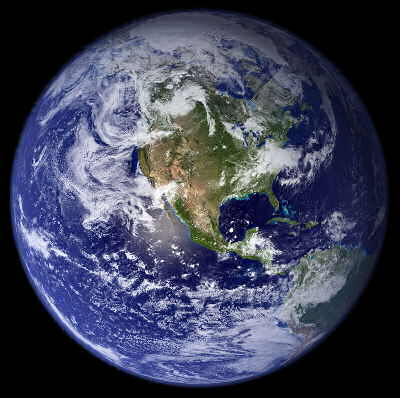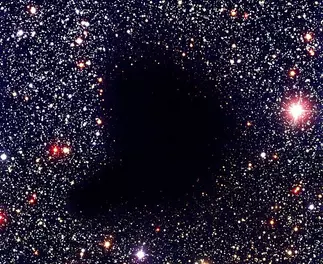Scientific Notation: Practice Problems
Solving Earth Science Problems with Scientific Notation
Introductory problems
These problems cover the fundamentals of writing scientific notation and using it to understand the relative size of values and scientific prefixes.
Problem 1: The distance to the moon is 238,900 miles. Write this value in scientific notation.
Step 1: Determine if the number is "large" or "small."
Since this number has lots of zeros to the left of the decimal point, it is large. Note that the decimal is effectively hidden to the right of the last zero.
Step 2. Determine which way to move the decimal.
For large numbers, we move the decimal to the left.
Step 3. Determine the number of places you need to move the decimal until the first number is greater than 1 but less than 10.
In our example, we need to move the decimal point five places to the left so that only the number 2 is to the left of the decimal.
Step 4. Determine the sign of the exponent as negative or positive.
In our example, we need to move the decimal left, and that means that the exponent is positive.
Step 5. Combine steps 3 and 4 to write the exponent.
Since we moved the decimal 5 places to the left, the exponent is positive and we write 105.
Step 6. Lastly, write the coefficient x 10exponent. Be sure to include units!
Problem 2: The age of the Earth is roughly 4,560,000,000 years. Write this in scientific notation.
Step 1. Determine if the number is "large" or "small."
Since this number has lots of zeros to the left of the decimal point, it is large.
Step 2. Determine which way to move the decimal point.
For large numbers, we move the decimal point to the left.
Step 3. Determine the number of places you need to move the decimal until the first number is greater than 1 but less than 10.
In our example, we need to move the decimal point nine places to the left, so that only the number 4 is to the left of the decimal point.
Step 4. Determine the sign of the exponent as negative or positive.
In our example, we need to move the decimal left, and that means that the exponent is positive.
Step 5. Combine steps 3 and 4 to write the exponent.
Since we moved the decimal 9 places to the left, the exponent is positive and we write 109.
Step 6. Lastly, write the coefficient x 10exponent. Be sure to include units!
4.6 109 years or 4.6 billion years.
Problem 3: The atomic radius of a magnesium atom is approximately 1.6 x 10-10 meters (m). How do you write this length in standard form?
Step 1. Determine if the exponent is positive or negative.
In this problem the exponent is negative, so we'll need to move the decimal point to the left in the next step.
Step 2. Determine the number of places to move the decimal by looking at the magnitude of the exponent.
In this problem the exponent is negative 10, so we'll need to move the decimal 10 places to the left and backfill any places beyond the coefficient with zeros.
Step 3. Write the coefficient using zeros as placeholders between the coefficient and the decimal point. As always, don't forget your units!
Because we moved the decimal point 10 places to the left, we write:
0.00000000016 m
Problem 4: Along the Mid-Atlantic Ridge, fissure A is 4 x 105 m in length and fissure B is 5 x 104 m in length. Convert these to decimal form and then determine which of these fissures is longer.
Step 1. Determine if the exponents are positive or negative.
Both exponents are positive, so we'll need to move the decimal to the right in the next step.
There is a shortcut to solve this problem, but work through the problem and then consider the shortcut.
Step 2. Determine the number of places to move the decimal by looking at the magnitude of the exponents.
For these values the exponents are positive 5 and 4 respectively, so we'll need to move the decimal 5 places to the right for fissure A and 4 places to the right for fissure B, adding zeros to the right of the coefficient.
Step 3. Write the coefficient using zeros as placeholders between the coefficient and the decimal. As always, don't forget your units!
Because we moved the decimal point to the right 5 places for fissure A and 4 places for fissure B places, we write:
Fissure A = 400,000 m
Fissure B = 50,000 m
This shows that fissure A is larger (by almost 10 times!). The shortcut to answer a question like this is to look at the exponent. If both coefficients are between 1 and 10, then the value with the larger exponent is the larger number.
Problem 5: The amount of carbon in the atmosphere is 750 petagrams (pg). One petagram equals 1 x 1015 grams (g). Write out the amount of carbon in the atmosphere in (i) scientific notation and (ii) standard decimal format.
Step 1. Convert the mass from petagrams to grams.
Set up your unit conversion from petagrams (pg) to grams (g):
`750 pg xx 1 xx 10^15 g/(pg) = 750 xx 10^15 g`
Notice the pg are in the numerator and denominator, so the terms cancel. Before we proceed, notice the coefficient is not between 1 and 10. To fix this, the decimal needs to move two places to the left. What happens to the exponent, when you move the decimal to the left?
Moving the decimal two places to the left increases the exponent by two.
`750 xx 10^15 g = 7.5 xx 10^17 g`
The exponent is a positive number, so the decimal point will move to the right in the next step.
Step 2. Determine the number of places to move the decimal point by looking at the magnitude of the exponent.
In this problem, the exponent is positive 17, so we'll need to move the decimal 17 places to the right and add zeros to the right of the coefficient.
Step 3. Write the coefficient using zeros as placeholders between the coefficient and the decimal point. As always, don't forget your units!
Because we moved the decimal point 17 places to the right, we write:
750,000,000,000,000,000 g
Advanced Problems
Scientific notation is used in solving these Earth and space science problems, and they are provided to you as an example. Be forewarned that these problems move beyond this module and require some facility with unit conversions, rearranging equations, and algebraic rules for multiplying and dividing exponents. If you can solve these, you've mastered scientific notation!
Problem 7: Calculate the volume of water (in cubic meters and in liters) falling on a 10,000 km2 watershed from 5 cm of rainfall.
Step 1. Recast all of your variables into scientific notation.
`10,000 km^2 = 1 xx 10^4 km^2`
5 cm of rainfall = `5 xx 10^0 cm`
Step 2. Convert all your variables into common units
We are interested in the volume of water in cubic meters and in liters.
Let's start with meters as the common unit and convert to liters later. There are 1 x 103 m in a km, and the area is km x km (km2) or m x m (m2); therefore you need to convert from km to m twice:
`1 xx 10^3 m/(km) * 1 xx 10^3 m/(km) = 1 xx 10^6 m^2/(km)^2`
`1 xx 10 m^2/(km)^2 * 1 xx 10^4 km^2 = 1 xx 10^10 m^2` for the area of the watershed.
For the amount of rainfall, you should convert from centimeters to meters:
`5 cm * (1 m)/(100 cm)= 5 xx 10^-2 m`
Step 3. Manipulate the formula to separate the unknown from the known variables.
We are asked to find a volume, and that is given by area (A) x the rainfall depth (d).
`V = A * d`
Step 4. Solve the equation using the algebraic rules for exponents.
When multiplying terms with exponents, you can multiply the coefficients and add the exponents:
`V = 1 xx 10^10 m^2 * 5 xx 10^(-2) m = 5 xx 10^8 m^3`
Given that there are 1 x 103 liters in a cubic meter, we can make the following conversion:
`1 xx 10^3 L * 5 xx 10^8 m^3 = 5 xx 10^11 L`
Step 5. Check your units and your answer; do they make sense?
Problem 8A: Dust grains are composed of silicon dioxide (SiO2) that resembles beach sand. If you approximate the dust grains as spheres with a radius of 2 x 10-6 meters, what is the volume of such a dust grain in cubic meters?
The equation for the volume of a sphere is:
`V = 4/3 pi r^3`
Using this equation, plug in the radius (r) of the dust grains.
`V = 4/3 pi (2 xx10^(-6))^3m^3`
Notice the (-6) exponent is cubed. When you take an exponent to an exponent, you need to multiply the two terms:
`V = 4/3 pi (8 xx10^(-18)m^3)`
Then, multiply the cubed radius times pi and 4/3:
`V = 3.35 xx 10^(-17) m^3`
Problem 8B: Silicon dioxide (SiO2) has a density of 3300 kg/m3. If mass = density x volume (m = dv), approximately what is the mass of one of these dust grains in kilograms (kg)?
Use the mass equation and plug in density and volume from problem 8A.
`m = 3.35 xx 10^(-17) m^3 * 3300 (kg)/m^3`
Notice in the equation above that the m3 terms cancel each other out, and you are left with kg.
`m = 1.1 xx 10^(-13) kg`
Problem 9: The Barnard 68 dark nebula has a radius of 0.25 light years, where 1 light year = 9.3 x 1015 meters. Suppose that the density of the dust grains is about 0.001 dust grain per cubic meter. What is the total mass of dust in this nebula?
To solve this problem, you need to determine the number of dust grains in the nebula and multiply it by the mass of one dust grain, which you determined in problem 8B.
Step 1. Determine the radius of the nebula.
The nebula is 0.25 light years in radius
`0.25 "light years" * 9.3xx10^15 m = 2.325xx10^15 m = r`
Step 2. Determine the volume of the nebula.
`V = 4/3 pi (2.325 xx10^(15) m)^3`
`V = 5.26 xx10^(46) m^3`
Step 3. Determine the number of grains within the nebula volume.
Number of dust grains = `5.26 xx10^(46) m^3 xx 0.001` grains/m3
Number of dust grains = `5.26xx10^43 "grains"`
Step 4. Determine the total mass of dust.
Total mass = `1.1xx10^(-13) (kg)/("grains") * 5.26xx10^43 "grains"`
Notice in the equation above the "grains" terms cancel each other out, and you are left with kg
Total mass = `5.79xx10^30 kg`
Next steps
TAKE THE QUIZ!!
I think I'm competent with scientific notation and I am ready to take the quiz! This link takes you to WAMAP. If your instructor has not given you instructions about WAMAP, you may not have to take the quiz.Or you can go back to the Scientific Notation explanation page.
 ×
Introductory problems
×
Introductory problems


